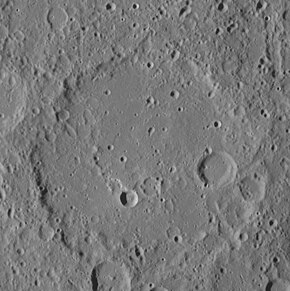
Pyotr Ilyich Tchaikovsky was a Russian composer during the Romantic period. He was the first Russian composer whose music would make a lasting impression internationally. Tchaikovsky wrote some of the most popular concert and theatrical music in the current classical repertoire, including the ballets Swan Lake and The Nutcracker, the 1812 Overture, his First Piano Concerto, Violin Concerto, the Romeo and Juliet Overture-Fantasy, several symphonies, and the opera Eugene Onegin.

Crater Lake is a volcanic crater lake in south-central Oregon in the Western United States. It is the main feature of Crater Lake National Park and is famous for its deep blue color and water clarity. The lake partly fills a 2,148-foot-deep (655 m) caldera that was formed around 7,700 years ago by the collapse of the volcano Mount Mazama. No rivers flow into or out of the lake; the evaporation is compensated for by rain and snowfall at a rate such that the total amount of water is replaced every 150 years. With a depth of 1,949 feet (594 m), the lake is the deepest in the United States. In the world, it ranks tenth for maximum depth, as well as third for mean (average) depth.
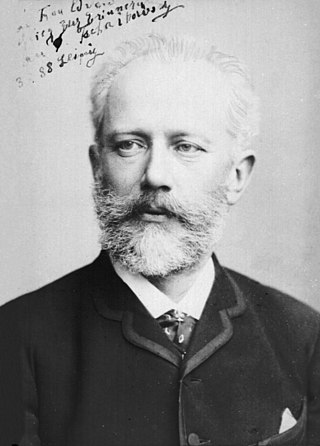
Swan Lake, Op. 20, is a ballet composed by Russian composer Pyotr Ilyich Tchaikovsky in 1875–76. Despite its initial failure, it is now one of the most popular ballets of all time.

The Nutcracker, Op. 71, is an 1892 two-act classical ballet by Pyotr Ilyich Tchaikovsky, set on Christmas Eve at the foot of a Christmas tree in a child's imagination. The plot is an adaptation of Alexandre Dumas' 1844 short story The Nutcracker, itself a retelling of E. T. A. Hoffmann's 1816 short story The Nutcracker and the Mouse King. The ballet's first choreographer was Marius Petipa, with whom Tchaikovsky had worked three years earlier on The Sleeping Beauty, assisted by Lev Ivanov. Although the complete and staged The Nutcracker ballet was not initially as successful as the 20-minute Nutcracker Suite that Tchaikovsky had premiered nine months earlier, it became popular in later years.

The International Tchaikovsky Competition is a classical music competition held every four years in Moscow and Saint Petersburg, Russia, for pianists, violinists, and cellists between 16 and 32 years of age and singers between 19 and 32 years of age. The competition is named after Russian composer Pyotr Ilyich Tchaikovsky.
Hamlet is a tragic play by William Shakespeare, based on the story of Jute prince Amleth.

The far side of the Moon is the lunar hemisphere that always faces away from Earth, opposite to the near side, because of synchronous rotation in the Moon's orbit. Compared to the near side, the far side's terrain is rugged, with a multitude of impact craters and relatively few flat and dark lunar maria ("seas"), giving it an appearance closer to other barren places in the Solar System such as Mercury and Callisto. It has one of the largest craters in the Solar System, the South Pole–Aitken basin. The hemisphere has sometimes been called the "Dark side of the Moon", where "dark" means "unknown" instead of "lacking sunlight" – each location on the Moon experiences two weeks of sunlight while the opposite location experiences night.
Romeo and Juliet, TH 42, ČW 39, is an orchestral work composed by Pyotr Ilyich Tchaikovsky. It is styled an Overture-Fantasy, and is based on Shakespeare's play of the same name. Like other composers such as Berlioz and Prokofiev, Tchaikovsky was deeply inspired by Shakespeare and wrote works based on The Tempest and Hamlet as well.

The Piano Concerto No. 1 in B♭ minor, Op. 23, was composed by Pyotr Ilyich Tchaikovsky between November 1874 and February 1875. It was revised in 1879 and in 1888. It was first performed on October 25, 1875, in Boston by Hans von Bülow after Tchaikovsky's desired pianist, Nikolai Rubinstein, criticised the piece. Rubinstein later withdrew his criticism and became a fervent champion of the work. It is one of the most popular of Tchaikovsky's compositions and among the best known of all piano concerti.
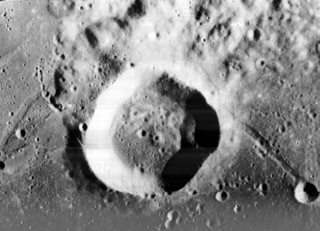
Lunar craters are impact craters on Earth's Moon. The Moon's surface has many craters, all of which were formed by impacts. The International Astronomical Union currently recognizes 9,137 craters, of which 1,675 have been dated.
Pyotr Ilyich Tchaikovsky (1840–1893) was a Russian composer.

The Ukrainian National Tchaikovsky Academy of Music, formerly Kyiv Conservatory, is a national music tertiary academy in Kyiv, Ukraine. Its courses include postgraduate education.
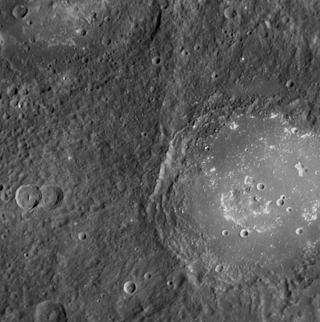
Lermontov is an impact crater on the planet Mercury. The crater is named after Mikhail Yuryevich Lermontov, a 19th-century Russian poet. The name was approved by the International Astronomical Union in 1976.
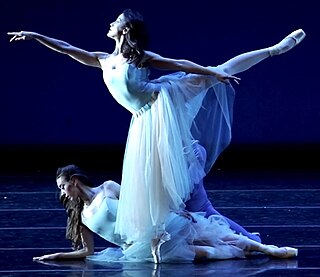
Serenade is a ballet by George Balanchine to Tchaikovsky's 1880 Serenade for Strings in C, Op. 48. Serenade is credited as being George Balanchine's first full-length ballet in America. Using the students of his newly formed School of American Ballet, Balanchine choreographed this ballet for an American audience that had not been widely exposed to ballet before. Students of the School of American Ballet gave the first performance on Sunday, 10 June 1934 on the Felix M. Warburg estate in White Plains, N.Y., where Mozartiana had been danced the previous day. It was then presented by the Producing Company of the School of American Ballet on 6 December at the Avery Memorial Theatre of the Wadsworth Atheneum with sets by the painter William Littlefield. Balanchine presented the ballet as his response to the generous sponsorships he received during his immigration to America. The official premiere took place on 1 March 1935 with the American Ballet at the Adelphi Theatre, New York, conducted by Sandor Harmati.

Pyotr Ilyich Tchaikovsky's relations with the group of composers known as the Belyayev circle, which lasted from 1887 until Tchaikovsky's death in 1893, influenced all of their music and briefly helped shape the next generation of Russian composers. This group was named after timber merchant Mitrofan Belyayev, an amateur musician who became an influential music patron and publisher after he had taken an interest in Alexander Glazunov's work. By 1887, Tchaikovsky was firmly established as one of the leading composers in Russia. A favorite of Tsar Alexander III, he was widely regarded as a national treasure. He was in demand as a guest conductor in Russia and Western Europe, and in 1890 visited the United States in the same capacity. By contrast, the fortunes of the nationalistic group of composers known as The Five, which preceded the Belyayev circle, had waned, and the group had long since dispersed; of its members, only Nikolai Rimsky-Korsakov remained fully active as a composer. Now a professor of musical composition and orchestration at the Saint Petersburg Conservatory, Rimsky-Korsakov had become a firm believer in the Western-based compositional training that had been once frowned upon by the group.

Giotto is a crater on Mercury. It has a diameter of 144 kilometers. Its name was adopted by the International Astronomical Union (IAU) in 1976. Giotto is named for the Italian painter Giotto di Bondone, who lived from 1271 to 1377.
